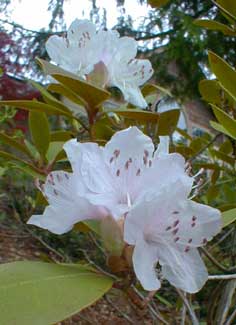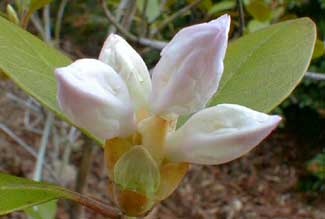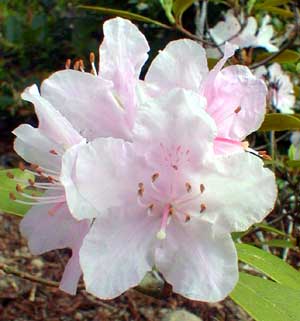
Piedmond Rhododendron;
or, Carolina Dwarf Rhododendron
"I want to wake up in the morning
Where the rhododendrons grow
Where the sun comes a-peeping
Into where I'm a-sleeping
And the songbirds sing hello.
I want to wander through the wildwood
Where the fragrant breezes blow
And drift back to the mountains
Where the rhododendrons grow."
-traditional folksong
West Virginia
West Virginia
 Rhododendron minus var minus (Carolinianum Group) is a dwarf version of R. carolinianum & sometimes so listed as a form of that species. In the wild it prefers wooded slopes at low elevations, typically along stream banks.
Rhododendron minus var minus (Carolinianum Group) is a dwarf version of R. carolinianum & sometimes so listed as a form of that species. In the wild it prefers wooded slopes at low elevations, typically along stream banks.It is found from east of the Mississippi River to the Atlantic coast in Canada & United States, & is especially common in the Carolinas, Georgia, & Tennessee.
 It was first described in 1792 by botanist, linguist, & explorer Andre Micheaux, whose wee potrtrait is reproduced on this page.
It was first described in 1792 by botanist, linguist, & explorer Andre Micheaux, whose wee potrtrait is reproduced on this page.Micheaux collected plants in the Appalachian & Blue Ridge Mountains for the French government. He travelled for eleven years amidst the woodlands & wildernesses of the eastern & southeastern United States.
He described 283 new species, of which the most lastingly important were this Piedbond Rhododendron, & the big-leaf magnolia (M. macrophylla). He not only introduced North American plants to French gardens, but also introduced American gardening to the crape myrtle (Lagerstroemia indica), & was a staunch promoter of camelias.
 The Piedmond rhododendron flowers May-June. Each small truss holds four to a dozen trumpets.
The Piedmond rhododendron flowers May-June. Each small truss holds four to a dozen trumpets.Specimens range in color from white to pink. Flowers of this specimen, which I photographed a month or two after installing it in a friend's landscape, start with pillowy white buds that open an almost pure white (as shown in the first two portraits) with just the faintest hint of pink.
As May progresses, the white blooms age to an exquisit, delicate light pink, getting slightly darker than the pink glow captured by the third portrait.
It looks like an old-fashioned tough-leafed Ironclad but scaled down in size. In the garden it tends to remain in the three to six foot range, but in the wild is often taller than ten feet.
Because of its extensive range throughout the American south, it tends to have quite varied habits, depending on where the original stock for a given strain originated. Many southern gardeners lament that so many rhodies are delicate in warmer climates, but this one would be ideal, especially if you can establish that the grower wasn't too far north.
Some shrubs are quite dwarfed, low-growing, & compact, others are more open & upright. This one is upright & rounded.
In the full open with too much afternoon sun, this shrub will be at risk of winter dessication from winds, & summer sun stress even though it is relatively heat hardy. It wants bright shade or dappled sunlight, but by no means deep shade. If stressed by droughtiness or too much shade it can attract spot disease.
It needs very well-draining soil to avoid root-rot, & an organically rich acidic soil for optimal growth. Given the proper location in the garden it will be extremely hardy, & despite its southern heritage can adapt to cooler regions, suited for USDA gardening zones 5 through 9.